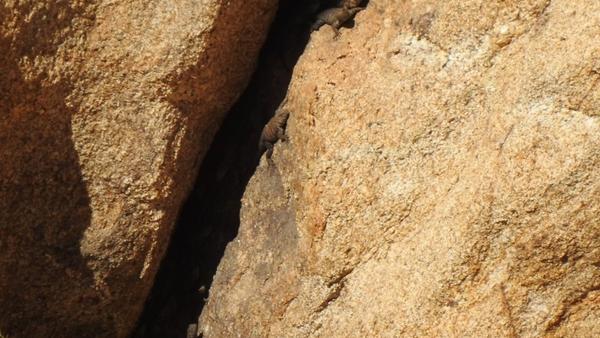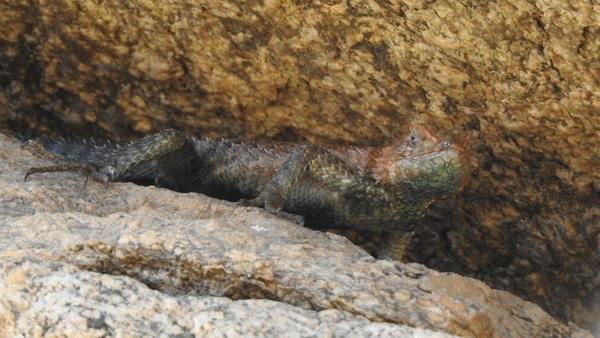It's Winter Outside
"The hard soil and four months of snow make the inhabitants of the northern temperate zone wiser and abler than his fellow who enjoys the fixed smile of the tropics. " — Ralph Waldo Emerson
In deserts we marvel at nature’s adaptations to heat and aridity. Plants reduce or eliminate leaves and leaf area as each leaf can siphon precious water from the plants into the dry air. Animals avoid the heat of the day, and in the case of reptiles wear a scaly coat that holds water in. Reptiles have been especially successful at exploiting deserts; for lizards, hot deserts around the world provide habitats for the highest levels of species richness, of lizard biodiversity.
As one heads poleward or to higher elevations, toward the colder latitudes and mountain slopes, lizard biodiversity drops off dramatically. Within a 100 km diameter circle centered on the Coachella Valley there are 33 native species of lizards, however, within that circle, at elevations above 7,000 feet there are just four species, and above 9,000 feet there is just one, barely. In California and Arizona combined, there are nearly 80 native lizard species; in all of Canada there are perhaps four or five, and those are clustered along the Canadian-U.S. border.
Yes, dealing with the problems associated with living in a hot and arid landscape is a challenge, but a challenge those lizards have solved. Living in a world where winters are long and frigid apparently creates problems mostly beyond solution for lizards.
During the waning centuries of the Pleistocene era, as the massive glaciers that covered Canada and the northern tier of the U.S. receded some 15-20,000 years ago, the land that was exposed was quickly exploited by plants, birds, mammals, and even some amphibians, but the lizards mostly did not take advantage of this new real estate. It is not that the high elevation and northern latitude summers are too short or not warm enough. The problem appears to be that the winters are just too cold. Even in hot deserts, winters tend to be cool. Most lizards avoid this cool down by burrowing into the soil or a rock crevice and then brumating. Brumation is essentially the same as hibernation but is restricted to reptiles and amphibians. Some scientists do not make that distinction and I am inclined to agree. The main difference is that when mammals go into hibernation they try to do so with a full stomach. Reptiles go into brumation with an empty stomach. While the body temperatures of both mammals and reptiles drop when hibernating or brumating, the mammals stay warm enough and continue digesting food, whereas reptiles do not have internal heating and so get colder, and what food might be left in their stomach can rot and potentially kill them. This difference is a clue as to why more lizards have not ventured north or to higher elevations.
I was recently listening to a discussion led by Dr. Nick Cairns, focusing on one of those few lizards that venture into Canada, the greater short-horned lizard. Greater short-horned lizards have the largest range of any lizard in North America, occurring from the high mountains of north-central Mexico through mostly the Rocky Mountains to the southern edge of Alberta and Saskatchewan in Canada. Nick studies this lizard in Saskatchewan and his recent research has focused on where they brumate. It turns out that where a lizard chooses to brumate will determine whether they survive the winter. The winters are cold in Saskatchewan and the ground freezes solid – except under the snow. Snow acts like a “warm” blanket, keeping ground temperatures just at or above freezing, but not cold enough to freeze solid. Scientists even have a term for this below snow environment, the subnivium, and there is apparently a winter ecosystem in the subnivium where some plants, arthropods, and other creatures can stay active during a Canadian winter. One can imagine that a three-month-old one-inch-long neonate greater short-horned lizard must make the most important decision of its young life, where will it brumate? Selecting a site where the fierce winter winds will blow the snow away means that it will certainly freeze and perish. Selecting a site where snow will accumulate means the lizard’s body will not freeze and thus it will secure its survival to the next year. Choose well and you have a chance to pass along your genes; choosing poorly will be the end of your genetic line.
Lizards occupying the higher elevations of desert mountain “sky islands” must have a similar choice to make. In southern California, southern sagebrush lizards, western skinks, granite spiny lizards, and granite night lizards can all be found above 7,000 feet, and the sagebrush lizard’s range brushes up against 9,000 feet. Of this foursome, the granite spiny lizards’ range extends much of the way down the Baja California peninsula and to lower elevations well below 1,000 feet – so it is not a high elevation-cold weather specialist, yet it still can be found at those higher elevations. These lizards are known to winter communally deep into rock crevices. The thought is that all those bodies in “bed” together keeps everyone warm enough to have better winter survival than would be the case if they went into brumation individually. One study counted 37 of these lizards brumating in a single crevice. Communal brumation is common in some species of snakes and may be one reason they are able to exploit habitats farther north than even the most northern lizards. This past fall, on one of our community science expeditions, we found a communal brumation crevice occupied by at least six granite spiny lizards at an elevation of 5,000 feet, the first such site I had ever seen.
Of these four lizard species, the southern sagebrush lizard is most restricted to high elevations, being only rarely encountered below 6,000 feet. This lizard has not been studied in sufficient detail to answer any questions about where they brumate. My guess is that answering those questions will provide insights as to how they can occupy such high elevations when other lizards cannot. Such a question is not merely academic. As climate change advances and temperatures warm and deserts become even more arid, we are seeing many if not most species shifting to increasingly higher, cooler, wetter elevations. Even as mean winter temperatures warm, they also have become more erratic with cold temperatures still occurring periodically. Will those cold, albeit erratic, temperatures limit how high into the sky islands species can sustain populations and so limit their ability to adapt to a warmer future?
Nullius in verba
Go outside, tip your hat to a chuckwalla (and a cactus), think like a mountain, and be safe.

